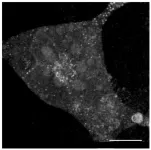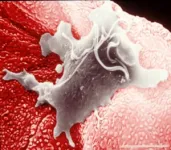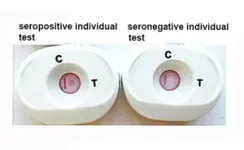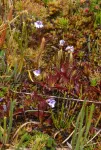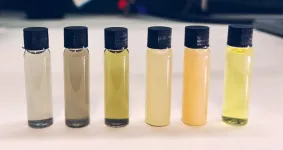(Press-News.org) INDIANAPOLIS, March 27, 2023 — Squids and octopuses are masters of camouflage, blending into their environment to evade predators or surprise prey. Some aspects of how these cephalopods become reversibly transparent are still “unclear,” largely because researchers can’t culture cephalopod skin cells in the lab. Today, however, researchers report that they have replicated the tunable transparency of some squid skin cells in mammalian cells, which can be cultured. The work could not only shed light on basic squid biology, but also lead to better ways to image many cell types.
The researchers will present their results at the spring meeting of the American Chemical Society (ACS). ACS Spring 2023 is a hybrid meeting being held virtually and in-person March 26–30, and features more than 10,000 presentations on a wide range of science topics.
For many years, Alon Gorodetsky, Ph.D., and his research group have been working on materials inspired by squid. In past work, they developed “invisibility stickers,” which consisted of bacterially produced squid reflectin proteins that were adhered onto sticky tape. “So then, we had this crazy idea to see whether we could capture some aspect of the ability of squid skin tissues to change transparency within human cell cultures,” says Gorodetsky, who is the principal investigator on the project.
The team at the University of California, Irvine focused their efforts on cephalopod cells called leucophores, which have particulate-like nanostructures composed of reflectin proteins that scatter light. Typically, reflectins clump together and form the nanoparticles, so light isn’t absorbed or directly transmitted; instead, the light scatters or bounces off of them, making the leucophores appear bright white.
“We wanted to engineer mammalian cells to stably, instead of temporarily, form reflectin nanostructures for which we could better control the scattering of light,” says Gorodetsky. That’s because if cells allow light through with little scattering, they’ll seem more transparent. Alternatively, by scattering a lot more light, cells will become opaque and more apparent. “Then, at a cellular level, or even the culture level, we thought that we could predictably alter the cells’ transparency relative to the surroundings or background,” he says.
To change how light interacts with cultured cells, Georgii Bogdanov, a graduate student in Gorodetsky’s lab who is presenting the results, introduced squid-derived genes that encoded for reflectin into human cells, which then used the DNA to produce the protein. “A key advance in our experiments was getting the cells to stably produce reflectin and form light-scattering nanostructures with relatively high refractive indices, which also allowed us to better image the cells in three dimensions,” says Bogdanov.
In experiments, the team added salt to the cells’ culture media and observed the reflectin proteins clumping together into nanostructures. By systematically increasing the salt concentration, Bogdanov got detailed, time-lapse 3D images of the nanostructures’ properties. As the nanoparticles became larger, the amount of light that bounced off the cells increased, consequently tuning their opacity.
Then, the COVID-19 pandemic hit, leaving the researchers to wonder what they could do to advance their investigation without being physically in the lab. So, Bogdanov spent his time at home developing computational models that could predict a cell’s expected light scattering and transparency before an experiment was even run. “It’s a beautiful loop between theory and experiments, where you feed in design parameters for the reflectin nanostructures, get out specific predicted optical properties and then engineer the cells more efficiently — for whatever light-scattering properties you might be interested in,” explains Gorodetsky.
On a basic level, Gorodetsky suggests that these results will help scientists better understand squid skin cells, which haven’t been successfully cultured in a laboratory setting. For example, previous researchers postulated that reflectin nanoparticles disassemble and reassemble to change the transparency of tunable squid leucophores. And now Gorodetsky’s team has shown that similar rearrangements occurred in their stable engineered mammalian cells with simple changes in salt concentration, a mechanism that appears analogous to what has been observed in the tunable squid cells.
The researchers are now optimizing their technique to design better cellular imaging strategies based on the cells’ intrinsic optical properties. Gorodetsky envisions that the reflectin proteins could act as genetically encoded tags that would not bleach inside human cells. “Reflectin as a molecular probe provides a lot of possibilities to track structures in cells with advanced microscopy techniques,” adds Bogdanov. For example, the scientists propose that imaging approaches based on their work could also have implications for better understanding cell growth and development.
The researchers acknowledge funding from the Defense Advanced Research Projects Agency and the U.S. Air Force Office of Scientific Research.
A recorded media briefing on this topic will be posted Monday, March 27, by 10 a.m. Eastern time at www.acs.org/acsspring2023briefings. Reporters can request access to media briefings during the embargo period by contacting newsroom@acs.org.
For health and safety information for ACS Spring 2023, please visit the FAQ webpage.
The American Chemical Society (ACS) is a nonprofit organization chartered by the U.S. Congress. ACS’ mission is to advance the broader chemistry enterprise and its practitioners for the benefit of Earth and all its people. The Society is a global leader in promoting excellence in science education and providing access to chemistry-related information and research through its multiple research solutions, peer-reviewed journals, scientific conferences, eBooks and weekly news periodical Chemical & Engineering News. ACS journals are among the most cited, most trusted and most read within the scientific literature; however, ACS itself does not conduct chemical research. As a leader in scientific information solutions, its CAS division partners with global innovators to accelerate breakthroughs by curating, connecting and analyzing the world’s scientific knowledge. ACS’ main offices are in Washington, D.C., and Columbus, Ohio.
To automatically receive news releases from the American Chemical Society, contact newsroom@acs.org.
Note to journalists: Please report that this research was presented at a meeting of the American Chemical Society.
Follow us: Twitter | Facebook | LinkedIn | Instagram
Title
Dynamic optical systems inspired by cephalopods
Abstract
Cephalopods (e.g., squids, octopuses, and cuttlefish) have captivated the imagination of both the general public and scientists alike due to their sophisticated nervous systems, complex behavioral patterns, and visually stunning coloration changes. By drawing inspiration from the structures and functionalities of tunable cephalopod skin cells, we have designed and engineered human cells that contain reconfigurable protein-based photonic architectures and, as a result, possess tunable transparency-changing and light-scattering capabilities (1). In turn, we have visualized the refractive index distributions of analogous engineered cells with three-dimensional label-free holotomographic microscopy techniques, and as a consequence, we have developed a detailed understanding of the relationship between their global optical characteristics and subcellular ultrastructures (2). We have moreover extended these efforts to the predictive engineering of the refractive indices and light-scattering properties of multiple self-assembled protein-based platforms, both in vitro and in vivo (2,3). Finally, we have developed improved chemical and genetic strategies for manipulating the sizes, numbers, and refractive indices of our subcellular structures (4). Our combined findings may facilitate an improved understanding of cephalopod camouflage mechanisms and lead to the development of unique tools for applications in biophotonics and bioengineering.
END
Human cells help researchers understand squid camouflage
2023-03-27
ELSE PRESS RELEASES FROM THIS DATE:
Genetic tests unexpectedly find genes linked to heart disease — now what?
2023-03-27
Statement Highlights:
As health care professionals, researchers and consumers increasingly use genetic testing, they are uncovering incidental genetic abnormalities, or variants, that are associated with cardiovascular diseases.
The statement writing committee cautions that incidentally identified single gene variants may or may not be risk factors for disease, so it is important to interpret them correctly and cautiously.
The new scientific statement offers a framework to support health care professionals in appropriately assessing individual genetic variants, communicating findings with patients and families, and, when ...
Biochar and energy from pyrolysis can pave the way for carbon-neutral agriculture in China
2023-03-27
Since the Paris Agreement to combat global warming was reached in 2015, many countries have committed to becoming climate neutral, i.e., achieving net-zero greenhouse gas emissions. The world's largest agricultural country, China, is also committed to join the green transition. As the largest agricultural country, China is also the world's biggest emitter of greenhouse gases, yet it has set itself a target of achieving carbon neutrality by 2060.
According to Professor and Head of Land-CRAFT at Department of Agroecology at Aarhus University Klaus Butterbach-Bahl, this places huge demands on agricultural systems: "Agriculture in China accounts ...
Two striking new species of carnivorous plants discovered in the Andes of Ecuador
2023-03-27
A team of botanists from Ecuador, Germany, and the United States has described two new species of carnivorous plants with striking appearance. They are part of the butterworts (genus Pinguicula), a group of flowering plants with about 115 species that can catch and digest small insects with their sticky leaves. Whereas the majority of butterwort species is distributed in the northern hemisphere, these new species were discovered in the high Andes of southern Ecuador, close to the border with Peru.
Carnivorous plants use animals (usually small insects) as an additional source of nutrients ...
Global population could peak below 9 billion in 2050s
2023-03-27
The new projection is significantly lower than several prominent population estimates, including those of the United Nations. The researchers go further to say that if the world takes a “Giant Leap” in investment in economic development, education and health then global population could peak at 8.5 billion people by the middle of the century.
The new projections by researchers from the Earth4All initiative for the Global Challenges Foundation is published as a working paper People and Planet, 21st Century Sustainable Population Scenarios and Possible Living Standards Within Planetary Boundaries.
The team used a new system ...
Looking from different perspectives! Proper electronic structure of near-infrared absorbing functional dyes discovered
2023-03-27
Near-infrared light, whose wavelength is longer than visible light, is invisible and can pass through many substances. Organic materials that efficiently absorb near-infrared light are essential for technological innovations that utilize near-infrared light, such as the dyes in the infrared blocking filters of smartphone cameras and security inks. These and many more technical applications make developing new dyes that can absorb longer wavelengths of near-infrared light desirable.
Previously, near-infrared absorbing organic materials were treated as closed-shell molecules without unpaired electrons. However, a joint research group led by Associate Professor Takeshi Maeda, Assistant Professor ...
Bodies of people with mental illness are biologically older than their actual age
2023-03-27
New research shows that people with a lifetime history of mental disorders such as depression, bipolar disorder, or anxiety disorders have blood markers suggesting that they are older than their actual age. This may go some way to explaining why people with mental health problems tend to have shorter lifespans and more age-related diseases than the general population.
Dr Julian Mutz and Prof Cathryn Lewis, from King’s College London, looked at data on 168 different blood metabolites from 110,780 participants in the UK Biobank2. They linked these data to information on whether individuals had a history of mental illness and found that those with a mental illness ...
Study identifies two promising molecular targets for drug development in recurrent and metastatic cervical cancer
2023-03-27
NRG Oncology GOG-0240 is the phase 3 randomized trial which demonstrated that the incorporation of bevacizumab with chemotherapy resulted in a statistically significant and clinically meaningful survival benefit for women with recurrent and metastatic cervical carcinoma (NCT00803062). GOG-0240 was a proof of concept in anti-angiogenesis therapy and a proof of principle in supportive care and led directly to an indication for bevacizumab in this disease in over 60 countries. Whole genome sequencing and whole exome sequencing of tumor samples obtained in GOG-0240 suggest that ARID1A and PIK3CA could represent potential targets ...
'Nano inks' could passively control temperature in buildings, cars
2023-03-27
World-first ‘phase change inks’ that could transform how we heat and cool buildings, homes and cars – to achieve sophisticated ‘passive climate’ control – have been developed, with enormous potential to help reduce energy use and global greenhouse gas emissions.
New research published in The Royal Society of Chemistry’s Journal of Materials Chemistry A led by Dr Mohammad Taha, documents proof-of-concept ‘phase change inks’ that use nanotechnology to control temperature in everyday environments. They achieve this by adjusting the amount of radiation that can pass through ...
Project helps thousands of people in England and France into employment and entrepreneurship
2023-03-27
New research led by the University of East Anglia (UEA) shows that large infrastructure projects which are the focus of the UK government’s levelling up agenda and include support for business start-ups, must also offer sustainable, local investment in deprived communities.
Through place-based micro-enterprise training and employment support over a longer time frame, lasting local impact can be demonstrated, according to the study’s policy recommendations.
Supporting people to return to their communities, increasing social cohesion within them, boosting digital literacy and enabling net zero jobs are also likely to play a role.
These goals can be easily ...
Embryos’ development is delayed in pregnancies that end in miscarriage
2023-03-27
Embryos in pregnancies that end in miscarriage take longer to develop in the womb than those in pregnancies that result in live births, according to new research published today (Monday) in Human Reproduction [1], one of the world’s leading reproductive medicine journals.
For the first time, researchers in The Netherlands have been able to look at the way embryos develop while pregnancies are ongoing. They used state-of-the-art imaging technology, including 3D ultrasound with high resolution transvaginal probes and ...
